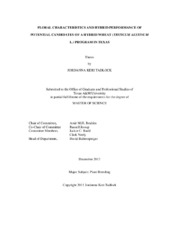| dc.description.abstract | Higher wheat prices, performance potential of hybrids and the availability of new next generation sequencing have sparked a renewed interest in the development of hybrid wheat. Floral characteristics and heterosis are an integral part of hybrid wheat studies for discovering compatible parents with desirable traits for hybrid wheat production. The objectives of this study were to 1) screen TAM germplasm for desirable floral characteristics and characterize the best male and female candidates for the beginning of a hybrid wheat program, and 2) to estimate heterosis in F2 generations as a proxy to F1.
Advanced breeding lines (1,770) from TAM germplasm, such as Amarillo Preliminary (AP1-AP10), South Texas Preliminary (STP1-STP4), South Texas Observations (SOBS), and Amarillo Observations (AOBS) were screened for floral characteristics to select parents for hybrid wheat crossing. The observations included studying the key male and female floral traits that will enhance the magnitude of cross-pollination. The male characteristics measured were anther exsertion, length and width, and female characteristics were glume angle and stigma size, featheriness duration and exsertion. Heading date, anthesis, and plant height were also measured. The study was conducted in two years: 2014 and 2015. Initial screening on 1,770 lines was performed during 2014 on a single replication. About 6% of the lines (97 out of 1,770) were selected from the 2014 floral screening and tested for repeatability in 2015. The 97 lines were grown in two replicates, and out of 97 lines, 17 (18%) were selected for hybrid wheat crossing.
Heterosis in TAM F2 populations College Station F2 (CF2) and Amarillo F2 (AF2) for yield and its components were studied as a proxy to the F1. Results showed that most of the F2 populations tend to have a higher yield and yield components than the inbred line checks. Though some heterosis is lost in the F2 due to segregation and inbreeding, the presence of superiority is a good sign of vigor in the previous generation. | en |


